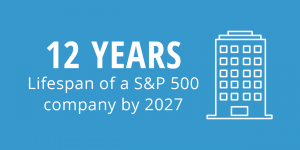With the accelerating rate of change and disruption, workforce planning has become even more critical to a company's survival.
But how can you ensure your business has the skills for today, tomorrow, and into the future?
The only constant is change
In 2019, McKinsey published a study charting turnover in the S&P 500 index, which lists the largest publicly traded companies in the US.
It showed that the average lifespan of an S&P 500-listed company had shifted from 35 years in the late 1970s to average closer to 20 years.
McKinsey predicted this would fall to 12 years by 2027.
The churn rate is more remarkable when you look at the tenure of the top 10; from 85 years in 2000, to 33 years by 2018.
In Australia, a 2019 Firstlinks analysis found of the 37,000 companies once listed on the ASX, only 2300 were still trading, of which 580 were profitable.

Creative destruction
So, what’s causing this?
According to famed Austrian economist Joseph Schumpeter, it’s all due to Creative Destruction, whereby incessant innovation replaces outdated processes and products.
Coined in 1942, the theory has been used to describe disruptive technologies such as the railroads, Henry Ford’s assembly line or – more recently – the internet.
However, the rate of change is accelerating.
Take personal transportation as an example: from horse-drawn carriage (3800 years) to taxi (120 years), Uber (seven years) to – on the horizon – self-driving car.
Essentially, industries are innovating at a faster pace.

Never done learning
Meanwhile, the time in which a job is in demand before innovation makes it obsolete is also getting shorter.
Looking again at transportation, the carriage driver transitioned to a taxi driver and now again is being supplanted thanks to the ubiquitousness of ride-hailing apps. Now, the self-driving car is on the horizon – an innovation that may make a driver in any form obsolete.
As John Seely Brown and Douglas Thomas write in A New Culture of Learning, “the half-life of a learned skill is five years”.
“This means that much of what you learned 10 years ago is obsolete and half of what you learned five years ago is irrelevant,” they said.
Workforce planning is a 'must'
So what does this mean for businesses today?
Apprenticeship Support Australia Manager Lena Constantine says it all comes down to workforce planning.
“Businesses need to make sure they've got a relevant and contemporary understanding of what's happening in the workforce or what's going to be needed in the future,” says Constantine.
“What’s critical for businesses is upskilling, reskilling and investing in your current staff to make sure they're meeting your business needs.”
WA's unique workforce challenges
Constantine says WA’s unique workforce challenges - competing with a high-paying resources sector for labour, attracting workers across state lines and tough skilled migration policies - further reinforces the need for a forward-thinking approach.
"Particularly in WA, it's about understanding the market that we're in and how critical your workers are to make sure that your business is productive, innovative, and can continue in the good times and the tough times,” she says.
"It's been acknowledged for years that workforce planning is important. However, what COVID has done has really amplified the need for it to be a necessity; it’s about survival.”
How does it work?
While there are a range of process models available for workplace planning, CCIWA advocates a seven-step process.
- Develop a business strategy
- Scan the environment
- Model the workforce
- Identify the skills gaps
- Develop a workforce strategy
- Implement the workforce strategy
- Monitor and report
Click on the links to explore CCIWA's workforce planning model.
Read Lena Constantine’s inaugural column examining workforce planning in the next edition of WA Works.






